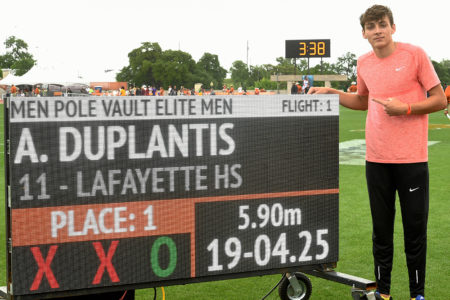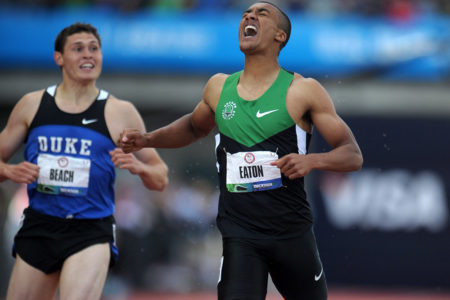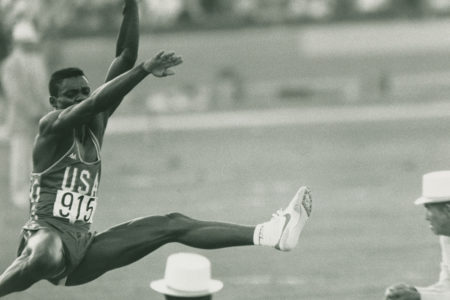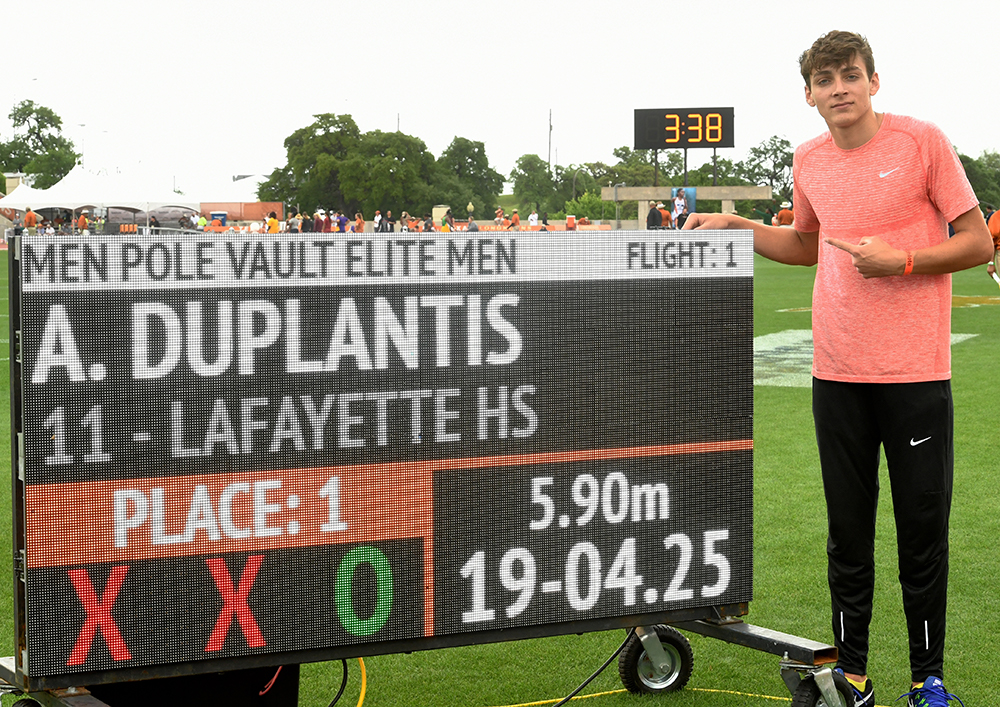
With the spectacular high school pages of Mondo Duplantis’s career over, he’s the highest prep vaulter ever and it’s easy to think he’s also the best ever. Some experts might argue he merely has an honored chair at a table with other greats who were also ahead of their time in an event that has seen technological advancement that is rivaled by almost no other event in the sport’s spectrum. Greg Duplantis—the father/coach of Mondo—says the principles of vaulting are pretty simple: “it hasn’t changed throughout time.”
The prime facet of greatness is dominance among one’s peers, especially all-time. Sometimes in prep vaulting greatness includes elevated status among the world’s best. Here’s a look back at some of the event’s biggest stars, although this is not a comprehensive list of all those who raised the national record (see end of article for the full progression).
Sherman Landers (1916)
Sherman Landers (Oregon, Illinois) was the ’16 world leader at 12-8, a High School Record that would last almost 7 years—the fifth-longest tenure of the HSR. While WWI virtually eliminated European activity, Landers’ mark was also significant in that it was just 4¼” off the WR at the time. That margin equals the closest a prep has been to the WR, and more than a century later Landers is listed with just two other prep vaulters with the same accomplishment.
Lee Barnes (1924)
Lee Barnes (Hollywood, California) had just graduated from high school when he won gold at the ’24 Paris Olympics 6 days before turning 18. Back then, four athletes from a country were allowed to compete in each event, and the U.S. foursome who tied for 1st in the Olympic Trials finished 1-2-3-6 in Paris. Barnes won the gold in a jumpoff, just as he did a month earlier at the Trials. No other prep vaulter has any other Olympic medal—or from the World Championships (introduced in ’83) or World Indoor Championships (’87). That year Barnes became the first prep over 13-feet and also finished the year with the world’s highest vault at 13-2—just the second time a U.S. prep would lead the yearly world list.
John Linta (1939)
The final HSR holder in the bamboo pole era was John Linta (Mansfield, Ohio), and his 13-9½ in ’39 was the national standard for nearly 14 years—the event’s longest stretch and lasting until the ’50s saw various forms of metal poles that helped vaulters achieve vastly superior heights.
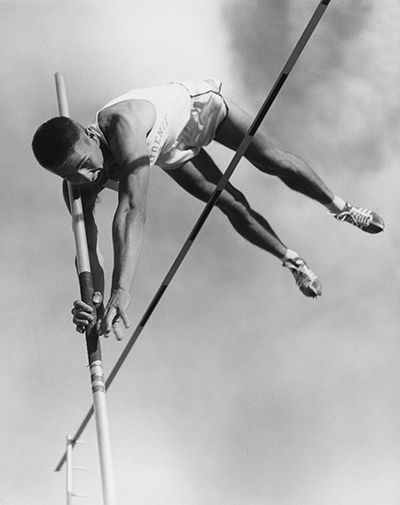
Jim Brewer (1955 & 1957)
Using metal poles, Jim Brewer (North, Phoenix, Arizona) broke two barriers, scaling 14-feet as a soph in ’55 and 15-feet as a senior in ’57 (with another national record in between in ’56). The 15-footer was so impressive at the time that we headlined it in the May ’57 issue thusly:
Phoenix, Arizona, May 15—Jim Brewer, the fabulous flyer from North Phoenix High School, climaxed his outstanding prep career tonight when he cleared what might well be the finest schoolboy performance of all time—the first 15-foot pole vault.
With that barrier-breaking performance Brewer held an 11½-inch margin over the next-highest prep—almost twice as much as ever before. That margin still stands among the very best to this day.
Paul Wilson (1964 & 1965)
The early ’60s saw an even more dramatic development in pole technology with the popularization of fiberglass. Paul Wilson (Warren, Downey, California) raised the HSR 6 times in ’64 & ’65, bursting over 16-feet and topping out at 16-6¾ as a senior. He was 5¾” higher than the next best prep, teammate Bob Steinhoff. His ’65 season was good enough to earn him No. 7 in T&FN’s World Rankings—the first prep vaulter to make that elite listing.
Casey Carrigan (1968 & 1969)
Casey Carrigan (Orting, Washington) was just a couple of weeks into his senior year when he made the Olympic team in September of ’68 by becoming the first 17-footer, hitting that barrier exactly.
In ’69, he put on an amazing show at Sacramento’s Golden West Invitational—breaking his own national record at 17‑½, then again at 17-4¾ and only missing at a would-be World Record of 17-10½. His 17-4¾ was just 4¼” off the WR, matching Landers’ difference as the closest by a prep. His three 17-footers would remain alone in prep annals for almost a decade.
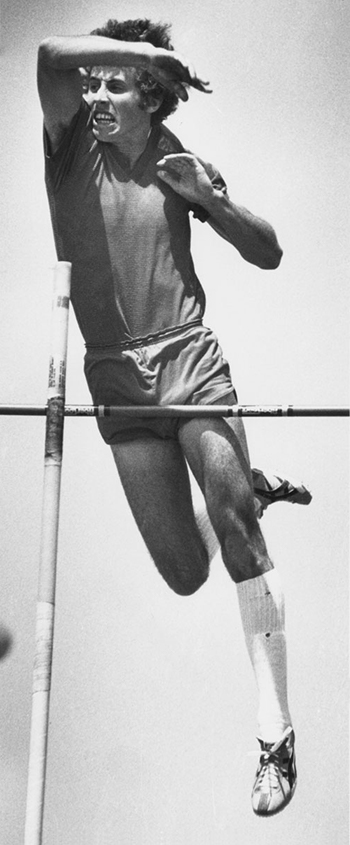
Joe Dial & Steve Stubblefield (1980)
While Carrigan’s record seemed to last forever, it was eventually broken twice in ’80, first by Joe Dial (Marlow, Oklahoma) and then by Steve Stubblefield (Wyandotte, Kansas City, Kansas). The latter’s 17-6 was the prime part of a season which made him just the third vaulter to earn HS AOY honors.
Joe Dial, Greg Duplantis & Dale Jenkins (1981)
The race to break 18-feet peaked in a dazzling year in which the national record was modified 8 times by 3 vaulters—Dial, Duplantis and Dale Jenkins (Abilene, Texas). It was briefly thought that Duplantis had the first prep 18-footer, in July. However, a post-clearance measurement found it just short at 17-11¾. He was using poles borrowed from Dial, who finished the summer at 18-1¼ and earned T&FN’s AOY honor.
Brandon Richards (1985)
That trio remained atop the all-time list until ’85, when Brandon Richards (San Marcos, Santa Barbara, California) scaled 18-2. His dad, Bob, had won Olympic gold in ’52 and ’56.
Brandon’s record lasted 13 years (second-longest ever) until ’99, when Eric Eshbach (Orangefield, Texas) HS edged ahead at 18-2¼. The next recordsetters were Tommy Skipper (Sandy, Oregon) at 18-3 in ’03, then Shawn Barber (Park, Kingwood, Texas) at 18-3½ in ’12, and Chris Nilsen (Park Hill, Kansas City, Missouri) at 18-4½ in ’16. Of this fivesome, only Skipper earned AOY honors, the others all finishing as runners-up.
Mondo Duplantis (2017 & 2018)
Mondo Duplantis (Lafayette, Louisiana) was No. 12 in the ’16 AOY voting as a soph, but he would never again receive another vote lower than 1st. As a junior he set the absolute best 6 times in a year when he amassed the 18 highest vaults ever by a prep, ultimately to 19-4¼ as he cleared 19-feet 3 times. He earned unanimous AOY honors and a No. 6 T&FN world ranking (matching Carrigan ’69 as the best by a prep vaulter). His 11¾” margin over the next best HS vaulter was the largest in history, just ahead of Brewer’s 11½” in ’57.
2018 was historic for preps in many ways. It saw a record 5 soaring over 18-feet, more than doubling the most in a single year. For the first time, three vaulters were among the HS AOY Top 10—Mondo returning as a unanimous No. 1 with Sondre Guttormsen (18-10¼) and K.C. Lightfoot (18-5) following at Nos. 4 and 7. Those three now lead the all-time HS list, a single-year trio at the top matched only once in history (1981).
Blowing the roof off was Mondo’s final prep campaign. He bettered his own previous HSR 5 times as he racked up 23 more 19-foot clearances to bring his career total to 26, making him by far the most dominant prep vaulter of his time. The crown jewel came when he won the European Championships at 19-10¼, the year’s world leader (a feat that matched Landers and Barnes a century earlier as the only preps with such an honor). At 19-10¼, Mondo is just 4¼” away from the WR, a difference matched only by Landers and Carrigan. His margin over the next-best prep grew just slightly to 12” (largest ever), and his No. 4 in the T&FN World Rankings surpassed the No. 6 prep best he shared with Carrigan. Overall, he ended up with 8 raisings of the national outdoor record, surpassing the 6’s by Wilson and Dial.
The best-ever prep vaulter? To High School Editor Jack Shepard, it’s a no-brainer. He considers Duplantis not only the best vaulter ever, but also the best prep period, ahead of Jim Ryun, Gerry Lindgren and Michael Carter, although he adds, “time will eventually tell.”

